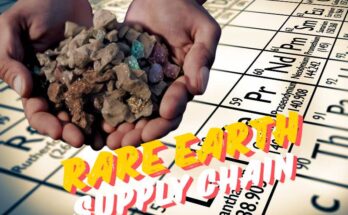AngloAmerican Streamlines Portfolio: Divesting Coking Coal, Platinum, Nickel, and Diamonds
AngloAmerican is set to divest its coking coal, platinum, nickel, and De Beers diamonds businesses
Streamlining its portfolio and enhancing shareholder value.
“AngloAmerican to Divest Its Coking Coal, Platinum, Nickel, and De Beers Diamonds Businesses” details a comprehensive restructuring within the mining conglomerate aimed at simplifying its portfolio and mitigating a takeover bid from BHP.
AngloAmerican will divest several key assets, including the coking coal mines in Queensland and its entire De Beers diamond subsidiary, with potential avenues being sales or an IPO. Additionally, there will be a demerger of AngloAmerican Platinum (AAP), along with divestment plans for ferronickel production sites in Brazil.
This strategic pivot aims to address undervaluation concerns and operational complexities linked with BHP’s offer, reflecting a calculated effort to streamline operations and bolster shareholder value while reducing capital expenditure commitments in other divisions.
AngloAmerican to Divest Its Coking Coal, Platinum, Nickel, and De Beers Diamonds Businesses
Have you been following the latest developments in the mining sector? Recently, AngloAmerican, a leading multinational mining company, made a groundbreaking announcement. The company is set to divest its coking coal, platinum, nickel, and De Beers diamonds businesses.
This move, shaped by a variety of strategic and operational factors, marks a significant shift in its portfolio management and operational approach. This comprehensive article delves into the specifics of the divestment, providing detailed insights and analyses.
The Big Decision: Divestment Unveiled
AngloAmerican’s decision to divest some of its major businesses is driven by a strategic review aimed at simplifying its portfolio. The company also aims to fend off a takeover bid from BHP, another giant in the mining industry. The divestment reflects a broader strategy to focus on assets that offer long-term growth potential and align with their core capabilities.
What Businesses Are Being Divested?
The divestment covers a diverse range of AngloAmerican’s assets, including:
- Coking Coal Assets: Moranbah North, Grosvenor Mines, Capcoal Open Cut, Aquila Underground Mines, and Dawson Mine in Queensland.
- Platinum Assets: AngloAmerican Platinum (AAP), which will be demerged from the parent company.
- De Beers Diamond Subsidiary: Potential separation with sales or IPO as options.
- Nickel Assets: Ferronickel production sites in Brazil.
Additionally, the company plans to reduce capital expenditure in the Woodsmith polyhalite fertilizer project by 2026.
Why Simplify the Portfolio?
The primary objective of AngloAmerican’s divestment strategy is to simplify its portfolio, making it more focused and manageable. Simplifying the portfolio helps in mitigating risks associated with operational complexities and enhancing shareholder value.
Avoiding BHP’s Takeover Bid
Another significant driver behind this decision is AngloAmerican’s need to fend off a takeover bid from BHP. The company believes that this strategic reorganization will highlight its true value, making a hostile takeover less attractive to potential bidders.
Coking Coal: A Detailed Divestment
Coking coal, also known as metallurgical coal, is used in steel production. AngloAmerican’s coking coal assets, specifically in Queensland, have been integral to its portfolio. However, divesting these assets forms a critical part of the company’s strategy to simplify its business operations.
Key Assets Being Divested
The following table summarizes the key coking coal assets being divested:
| Coking Coal Asset | Location |
|---|---|
| Moranbah North Mine | Queensland, Australia |
| Grosvenor Mine | Queensland, Australia |
| Capcoal Open Cut | Queensland, Australia |
| Aquila Underground Mine | Queensland, Australia |
| Dawson Mine | Queensland, Australia |
Why Divest Coking Coal Assets?
Given the increasing focus on reducing carbon footprints and shifting towards cleaner energy sources, AngloAmerican sees divesting its coking coal assets as a strategic move. This step aligns with global trends and regulatory pressures aimed at sustainability.
The Impact of Divestment
The divestment of coking coal assets will help AngloAmerican streamline its operations and redirect resources towards high-growth, sustainable ventures. It will also mitigate risks associated with market volatility in the coal industry and align with the company’s long-term strategic vision.
Platinum: The Planned Demerger of AngloAmerican Platinum
AngloAmerican Platinum (AAP) is one of the world’s leading producers of platinum. The planned demerger of AAP is a pivotal part of AngloAmerican’s divestment strategy. This move aims to create a more focused and operationally efficient company.
What is a Demerger?
A demerger involves splitting off a subsidiary or business unit from the parent company, creating a separate entity. This process allows the separated entity to operate independently, enabling more agility and targeted strategic initiatives.
The Rationale Behind the Demerger
The decision to demerge AAP is driven by:
- Enhanced Operational Focus: Allowing AAP to operate as an independent entity will enable it to tap into specific growth opportunities in the platinum sector.
- Value Realization: The demerger is expected to unlock value for shareholders, making it easier to evaluate the performance and potential of AAP as a standalone entity.
- Market Dynamics: By allowing AAP to focus solely on the platinum market, AngloAmerican can better align its business strategy with market demands and opportunities.
Expected Benefits of the Demerger
The demerger is anticipated to provide several benefits, including:
- Increased Shareholder Value: The market often values focused entities more highly, potentially leading to a higher valuation for both AngloAmerican and AAP.
- Operational Efficiency: AAP can streamline its operations and concentrate on its core competencies without the overarching strategic constraints of the parent company.
- Strategic Flexibility: An independent AAP will have greater flexibility to pursue strategic opportunities, partnerships, and investments specific to the platinum market.
De Beers Diamonds: Exploring Separation Options
De Beers, a subsidiary of AngloAmerican, is one of the most renowned names in the diamond industry. The potential separation of De Beers is another significant element of AngloAmerican’s divestment plan. The company is exploring options, including a sale or an initial public offering (IPO).
Why Consider Separation?
The separation of De Beers is driven by several factors:
- Valuation Enhancement: By spinning off De Beers, AngloAmerican can unlock the intrinsic value of the diamond business, potentially realizing a higher market valuation.
- Focused Operations: Like AAP, De Beers can benefit from operating as a standalone entity, allowing for more tailored strategies and operational efficiencies.
- Market Perception: A separate De Beers entity can attract investors specifically interested in the diamond industry, enhancing its market perception and financial performance.
Sale vs. IPO: Weighing the Options
AngloAmerican is considering two primary options for De Beers:
- Sale: Selling De Beers to another company could provide immediate financial returns and allow AngloAmerican to redeploy capital into other ventures.
- IPO: Launching an IPO would create a publicly traded De Beers entity, providing ongoing access to capital markets and potential liquidity for AngloAmerican’s shareholders.
Strategic and Operational Implications
The separation of De Beers will have strategic and operational implications, including:
- Strategic Realignment: AngloAmerican can realign its strategic focus on core assets and high-growth opportunities.
- Operational Independence: De Beers will have the agility to respond to market dynamics and pursue growth initiatives specific to the diamond industry.
- Financial Flexibility: The separation will provide financial flexibility for both entities, enabling targeted investments and strategic initiatives.
Nickel: Divesting Ferronickel Production Sites in Brazil
AngloAmerican’s ferronickel production sites in Brazil are also on the divestment list. Ferronickel, an alloy of iron and nickel, is used in the production of stainless steel and other alloys.
Key Ferronickel Production Sites in Brazil
The ferronickel production sites in Brazil include:
- Codemin Operation: Located in Goiás, it is one of the primary ferronickel production sites.
- Barro Alto Project: Another significant site, contributing substantially to AngloAmerican’s ferronickel output.
Strategic Rationale for Divesting Ferronickel Assets
Several strategic reasons underpin the divestment of ferronickel assets:
- Focus on Core Assets: The divestment is aligned with AngloAmerican’s strategy to focus on its core profitable assets, reducing operational complexities.
- Market Opportunities: Selling these assets provides an opportunity to capitalize on favorable market conditions for nickel and streamline operations.
- Resource Allocation: Freeing up resources and capital from ferronickel production will enable the company to invest in higher growth and sustainable ventures.
Benefits of Divesting Ferronickel Assets
The divestment of ferronickel production sites is expected to yield several benefits:
- Operational Simplification: Reducing operational complexity and focusing on core assets.
- Financial Gains: Potential financial returns from the sale can be reinvested into strategic growth areas.
- Strategic Alignment: The divestment supports AngloAmerican’s broader strategic objectives, enhancing overall operational and financial performance.
Woodsmith Polyhalite Fertilizer Project: Reduced Capital Expenditure
The Woodsmith polyhalite fertilizer project in the UK is another critical area where AngloAmerican plans to reduce capital expenditure by 2026. This project involves the extraction of polyhalite, a mineral used as fertilizer.
Overview of the Woodsmith Polyhalite Project
The Woodsmith project, located in North Yorkshire, UK, aims to produce polyhalite fertilizer—a valuable resource for the agriculture industry. The project is significant in size and scope, representing a notable part of AngloAmerican’s portfolio.
Why Reduce Capital Expenditure?
Reducing capital expenditure in the Woodsmith project is driven by:
- Cost Management: Managing costs effectively to ensure the project remains financially viable.
- Resource Allocation: Reallocating resources towards higher-growth opportunities and core assets.
- Strategic Flexibility: Providing flexibility to adapt to market conditions and strategic priorities.
Expected Impact of Capital Expenditure Reduction
The reduction in capital expenditure is expected to have several impacts:
- Financial Efficiency: Improved financial efficiency by controlling costs without compromising project viability.
- Strategic Focus: Enhanced focus on core projects and strategic initiatives.
- Market Adaptability: Greater adaptability to market changes and strategic opportunities.
Understanding the Broader Implications
AngloAmerican’s decision to divest its coking coal, platinum, nickel, and De Beers diamonds businesses has broad implications for the company and the mining industry.
Strategic Realignment
This strategic realignment helps AngloAmerican focus on its core assets, reducing operational complexities and enhancing shareholder value. By concentrating on high-growth, sustainable opportunities, the company is better positioned for long-term success.
Financial Flexibility
The divestments provide AngloAmerican with financial flexibility, enabling the redeployment of capital into strategic growth areas. This financial agility is crucial in navigating the evolving market landscape and capturing emerging opportunities.
Market Dynamics
By simplifying its portfolio, AngloAmerican can respond more effectively to market dynamics and regulatory changes. This agility supports the company’s goal of becoming a more focused and efficient entity, capable of delivering sustained value to shareholders.
Environmental and Social Governance (ESG)
Focusing on sustainable and high-growth assets aligns with AngloAmerican’s commitment to environmental and social governance (ESG). The divestments support the company’s efforts to reduce its carbon footprint and contribute positively to global sustainability goals.
Conclusion
AngloAmerican’s decision to divest its coking coal, platinum, nickel, and De Beers diamonds businesses marks a significant shift in its strategic and operational approach.
By simplifying its portfolio and focusing on core, high-growth opportunities, the company aims to enhance shareholder value, operational efficiency, and ESG commitments.
The divestments, including the planned demerger of AngloAmerican Platinum, the potential separation of De Beers, and the reduction in capital expenditure for the Woodsmith polyhalite project, reflect a strategic realignment designed to position AngloAmerican for long-term success.
As the company navigates through this transformative phase, stakeholders can expect a more agile, focused, and sustainable AngloAmerican—well-positioned to thrive in the dynamic mining industry.
Thank you for joining us in exploring the intricate details of AngloAmerican’s divestment strategy. Stay tuned for more updates and insights into the ever-evolving world of mining and strategic business transformations.


